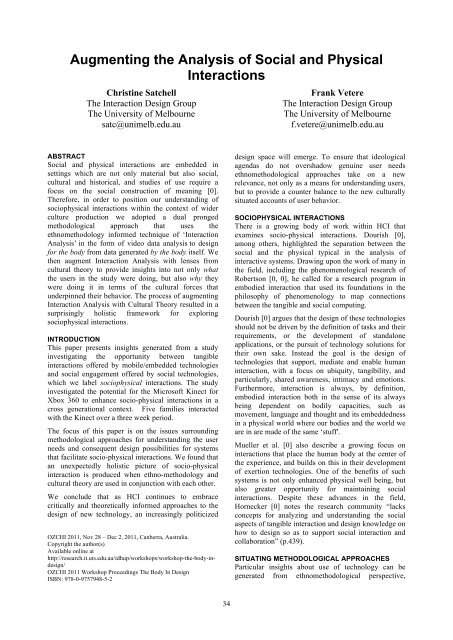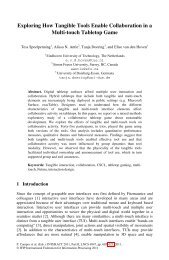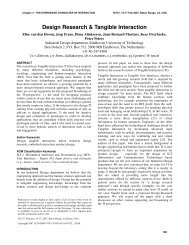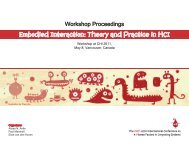Sissy - Elise van den Hoven
Sissy - Elise van den Hoven
Sissy - Elise van den Hoven
You also want an ePaper? Increase the reach of your titles
YUMPU automatically turns print PDFs into web optimized ePapers that Google loves.
Augmenting the Analysis of Social and Physical<br />
Interactions<br />
Christine Satchell<br />
The Interaction Design Group<br />
The University of Melbourne<br />
satc@unimelb.edu.au<br />
ABSTRACT<br />
Social and physical interactions are embedded in<br />
settings which are not only material but also social,<br />
cultural and historical, and studies of use require a<br />
focus on the social construction of meaning [0].<br />
Therefore, in order to position our understanding of<br />
sociophysical interactions within the context of wider<br />
culture production we adopted a dual pronged<br />
methodological approach that uses the<br />
ethnomethodology informed technique of ‘Interaction<br />
Analysis’ in the form of video data analysis to design<br />
for the body from data generated by the body itself. We<br />
then augment Interaction Analysis with lenses from<br />
cultural theory to provide insights into not only what<br />
the users in the study were doing, but also why they<br />
were doing it in terms of the cultural forces that<br />
underpinned their behavior. The process of augmenting<br />
Interaction Analysis with Cultural Theory resulted in a<br />
surprisingly holistic framework for exploring<br />
sociophysical interactions.<br />
INTRODUCTION<br />
This paper presents insights generated from a study<br />
investigating the opportunity between tangible<br />
interactions offered by mobile/embedded technologies<br />
and social engagement offered by social technologies,<br />
which we label sociophysical interactions. The study<br />
investigated the potential for the Microsoft Kinect for<br />
Xbox 360 to enhance socio-physical interactions in a<br />
cross generational context. Five families interacted<br />
with the Kinect over a three week period.<br />
The focus of this paper is on the issues surrounding<br />
methodological approaches for understanding the user<br />
needs and consequent design possibilities for systems<br />
that facilitate socio-physical interactions. We found that<br />
an unexpectedly holistic picture of socio-physical<br />
interaction is produced when ethno-methodology and<br />
cultural theory are used in conjunction with each other.<br />
We conclude that as HCI continues to embrace<br />
critically and theoretically informed approaches to the<br />
design of new technology, an increasingly politicized<br />
OZCHI 2011, Nov 28 – Dec 2, 2011, Canberra, Australia.<br />
Copyright the author(s)<br />
Available online at<br />
http://research.it.uts.edu.au/idhup/workshops/workshop-the-body-indesign/<br />
OZCHI 2011 Workshop Proceedings The Body In Design<br />
ISBN: 978-0-9757948-5-2<br />
34<br />
Frank Vetere<br />
The Interaction Design Group<br />
The University of Melbourne<br />
f.vetere@unimelb.edu.au<br />
design space will emerge. To ensure that ideological<br />
agendas do not overshadow genuine user needs<br />
ethnomethodological approaches take on a new<br />
rele<strong>van</strong>ce, not only as a means for understanding users,<br />
but to provide a counter balance to the new culturally<br />
situated accounts of user behavior.<br />
SOCIOPHYSICAL INTERACTIONS<br />
There is a growing body of work within HCI that<br />
examines socio-physical interactions. Dourish [0],<br />
among others, highlighted the separation between the<br />
social and the physical typical in the analysis of<br />
interactive systems. Drawing upon the work of many in<br />
the field, including the phenomenological research of<br />
Robertson [0, 0], he called for a research program in<br />
embodied interaction that used its foundations in the<br />
philosophy of phenomenology to map connections<br />
between the tangible and social computing.<br />
Dourish [0] argues that the design of these technologies<br />
should not be driven by the definition of tasks and their<br />
requirements, or the development of standalone<br />
applications, or the pursuit of technology solutions for<br />
their own sake. Instead the goal is the design of<br />
technologies that support, mediate and enable human<br />
interaction, with a focus on ubiquity, tangibility, and<br />
particularly, shared awareness, intimacy and emotions.<br />
Furthermore, interaction is always, by definition,<br />
embodied interaction both in the sense of its always<br />
being depen<strong>den</strong>t on bodily capacities, such as<br />
movement, language and thought and its embeddedness<br />
in a physical world where our bodies and the world we<br />
are in are made of the same ‘stuff'.<br />
Mueller et al. [0] also describe a growing focus on<br />
interactions that place the human body at the center of<br />
the experience, and builds on this in their development<br />
of exertion technologies. One of the benefits of such<br />
systems is not only enhanced physical well being, but<br />
also greater opportunity for maintaining social<br />
interactions. Despite these ad<strong>van</strong>ces in the field,<br />
Hornecker [0] notes the research community “lacks<br />
concepts for analyzing and understanding the social<br />
aspects of tangible interaction and design knowledge on<br />
how to design so as to support social interaction and<br />
collaboration” (p.439).<br />
SITUATING METHODOLOGICAL APPROACHES<br />
Particular insights about use of technology can be<br />
generated from ethnomethodological perspective,



![Download 1.8 MB [pdf] - Elise van den Hoven](https://img.yumpu.com/18078175/1/190x245/download-18-mb-pdf-elise-van-den-hoven.jpg?quality=85)

![Download 0.2 MB [pdf] - Elise van den Hoven](https://img.yumpu.com/18078145/1/182x260/download-02-mb-pdf-elise-van-den-hoven.jpg?quality=85)
![Download 0.1 MB [pdf] - Elise van den Hoven](https://img.yumpu.com/18078125/1/190x146/download-01-mb-pdf-elise-van-den-hoven.jpg?quality=85)
![Download 1.9 MB [pdf] - Elise van den Hoven](https://img.yumpu.com/18078041/1/182x260/download-19-mb-pdf-elise-van-den-hoven.jpg?quality=85)

